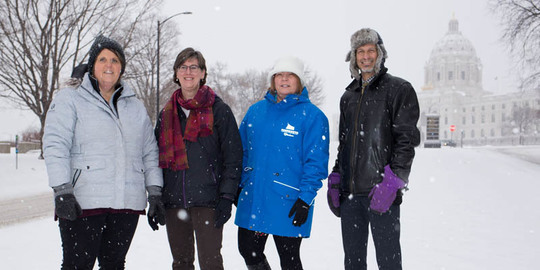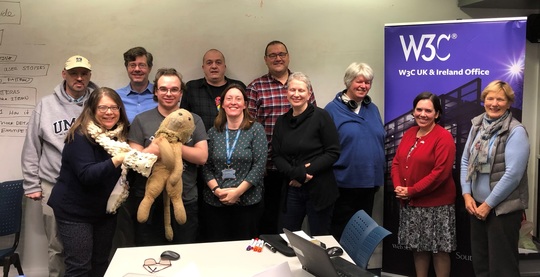CSUN, Here They Come!
 Pictured above from left to right: Kim Wee, Kris Schulze, JoAnn Rautio, and Jay Wyant.
CSUN is the place to be to learn about digital accessibility. The California State University Northridge (CSUN, pronounced see-sun) Center on Disabilities is hosting the 34th annual Assistive Technology Conference that brings together subject matter experts to discuss everything about assistive technology and digital accessibility, including:
- The role of artificial intelligence in user-centered design and development.
- Managing requirements and testing in an agile lifecycle.
- Techniques for making accessible Office 365 documents.
- Improvements to voice input options for mobile and desktop applications.
Minnesota IT Services (MNIT) staff will again participate in this event that attracts a nationwide audience and major industry vendors, like Microsoft and Amazon. Information learned at past conferences has influenced how the state tests for accessibility, and how we design documents and web pages. It has informed us about new assistive technologies that are providing even greater independence for individuals with disabilities.
MNIT and other State of Minnesota agency staff have given presentations at past conferences, and this year is no exception. Jay Wyant, Chief Information Accessibility Officer and Kris Schulze, MNIT User Experience Manager will discuss “Integrating Local and Remote Meeting Participants.” JoAnn Rautio, MNIT Accessibility Coordinator and Business Analyst partnering with the Department of Employment & Economic Development and Kim Wee, MNIT Webmaster and Accessibility Coordinator partnering with the Department of Education will discuss the Map Accessibility Workgroup's framework and best practices. Our blog article CSUN, Here They Come! has more information about their presentations, how the state has benefited from attending in previous years, and how to follow their updates while they are there.
What is COGA?
 People need to know about things from the government. In Minnesota, agencies put this information on the web. The agencies follow the State Accessibility Standard to make sure web content is easy to use or understand. But people with cognitive disabilities may have trouble using the web. They may not read well, or have trouble with memory. The web accessibility standard does not meet all their needs. We can do more.
The W3C Web Accessibility Initiative sets the Web Content Accessibility Guidelines (WCAG). WCAG is part of the state standard. This group has a task force called the Cognitive and Learning Disabilities Accessibility Task Force, or COGA. COGA helps people understand why people have trouble using the web. Then they show people how to make it better. They also make suggestions to improve the guidelines. The task force considers many disabilities including:
- Learning disabilities
- Developmental disabilities
- Autism
- Acquired cognitive disabilities such as brain injuries
- Neurologic issues such as dementia
- Mental health conditions that impact memory and/or executive functioning
Thirteen COGA members and experts from around the world met in January.
What kinds of challenges using the web do they discuss? Learn more about their work and their resources in our blog What is COGA?
|